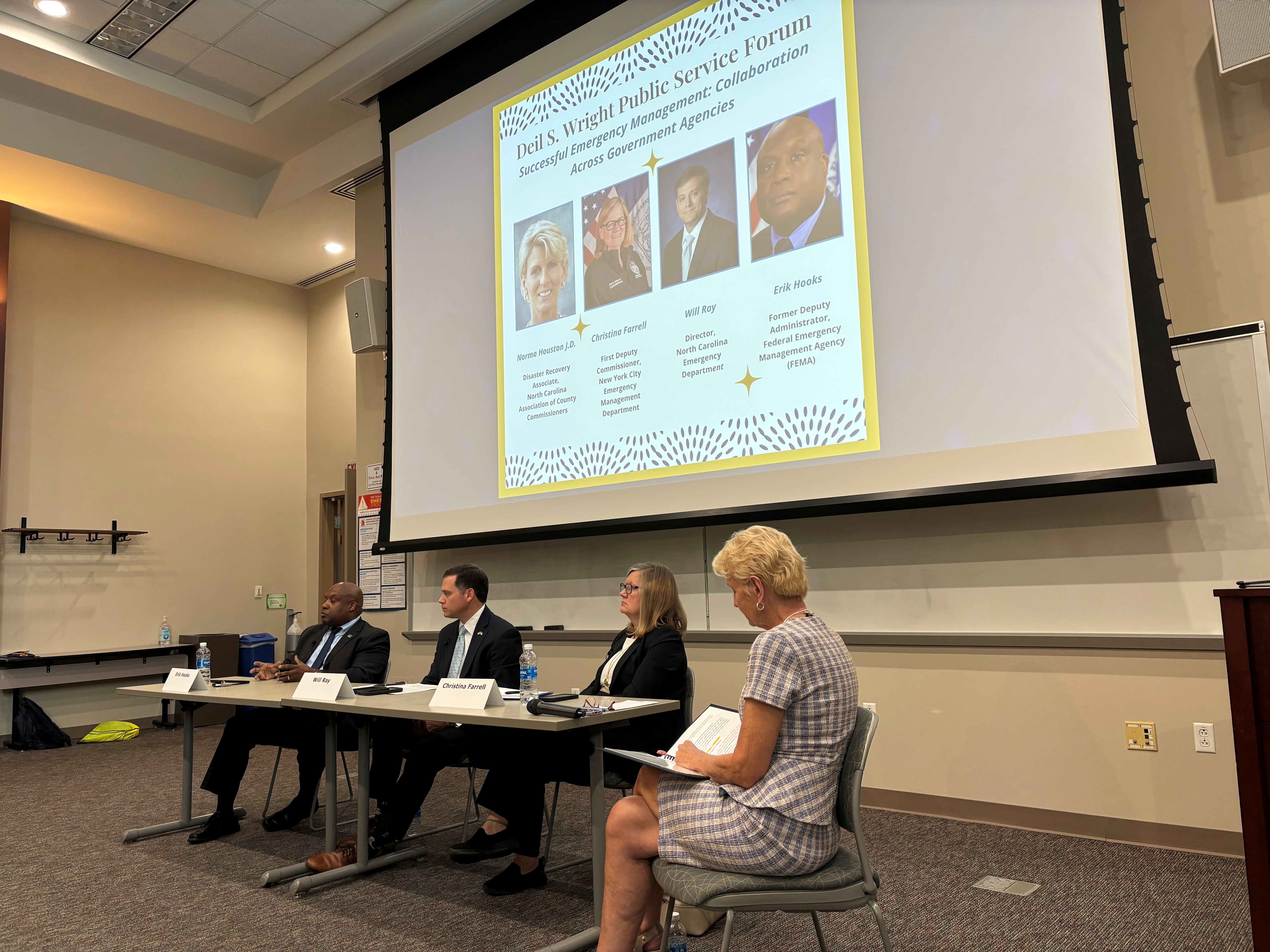The life cycle of emergency management: Local, state, and federal experts gather for the 2025 Deil S. Wright Lecture
Students, faculty, staff, alumni, and supporters of the UNC Master of Public Administration program gathered Friday, October 10, 2025, to participate in the annual Deil S. Wright Public Service Forum. This year’s topic was “Successful Emergency Management: Collaboration Across Government Agencies.” The event was moderated by Norma Houston, former School of Government faculty member and chief of staff to UNC President Peter Hans. Houston, herself an emergency management expert, introduced and moderated the panelists:
- Christina Farrell: First Deputy Commissioner, New York City Emergency Management Department and UNC MPA alumna
- Erik Hooks: Former Deputy Administrator, Federal Emergency Management Agency (FEMA)
- Will Ray: Director, North Carolina Emergency Management
Houston highlighted the enduring importance of emergency management, noting for the students in the audience that their public service careers will intersect with the topic at some point.
“Disasters take all forms—hurricanes, wildfires, cyberattacks, terrorist threats,” she said. “If you are working for government, a community organization, a nonprofit, or in some form or fashion serving your community, in all likelihood you will be involved in disaster response and recovery.”
The panelists discussed the process of emergency management response as following a life cycle of sorts, with each panelist representing a stage within it—from initial local government response, to state government backup, to the federal government providing needed support upon request.
The system works optimally, according to Hooks, when the federal government is informed about the emergency and primed to provide recovery to local units early in the process.
“Emergencies begin and end locally,” he said. “The federal government is at its best when it is pre-postured and pre-positioned to support the state and local government response early—to pre-position assets and to have incident management teams on the ground before a storm hits.”
The panelists discussed how to handle emergencies in an era where misinformation and disinformation are increasingly spreading online. Ray said the key is to be the most trusted, transparent source of information in the room.
“The trust you engender with the general public is the currency you trade on. You have to be transparent. You have to be genuine and honest with the public about what you know and what you don't know.”
Farrell, for her part, said that information increasingly being shared in echo chambers can harm government’s ability to provide needed aid in the wake of a disaster. She said public officials should use different channels to reach communities that may not rely on traditional media for accessing resources and information when an emergency strikes.
“A message that works in one neighborhood or one part of the city is not going to work in another one,” she said. “In some areas, they may not trust the government or they may have fled their government. So, take that cultural competency into account—look for ways to get information out and identify the people that can help you get that message out to certain communities so that you reach everybody.”
Hooks spoke about three keys to government’s ultimate success in emergency management: partnerships, leadership, and intentional collaboration.
“Partnerships are established long before a storm comes, and leadership must come from every level of the response,” he said. “But when you are working toward a common good, the key is collaboration, collaboration before an event happens. That's the training together. That's ensuring that you—if you're the source of allocation dollars—are getting the money and the resources down range to those partners out there.”
Closing the discussion, Ray concurred with Hooks about the need for intergovernmental partnerships—particularly to be formed and nourished before disasters occur . He emphasized that while emergency management officials are most visible during disaster recovery, the majority of their work actually comes from preparation to ensure damage from future emergency events is minimized.
“Natural hazards are when people see us the most. I would argue that's a very small percentage of what we're actually doing. And if we're doing our job right, and we're doing our job well, you don't see how we are operating behind the scenes.”
At the conclusion of the forum, Farrell was honored by Ray for her department’s support of North Carolina following Hurricane Helene in October 2024. Ray gifted her with a North Carolinian flag that was flown on rescue aircraft during the aftermath of the storm.
The Deil S. Wright Public Service Forum carries on the tradition of honoring distinguished UNC MPA faculty member Deil Wright for his 34 years of teaching, mentorship, and scholarship in the MPA program. It expands upon the Deil S. Wright Lecture in Public Administration, an event launched in 2002 that invited a distinguished professional from the field of public administration to enrich the educational experience of the MPA community.
Published October 16, 2025



